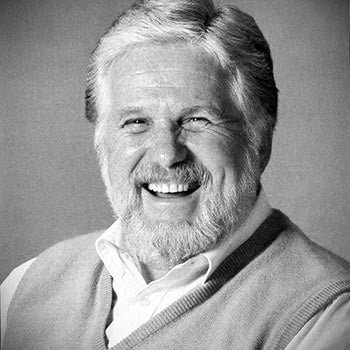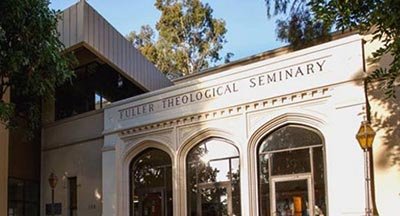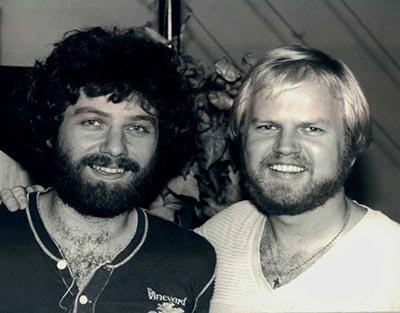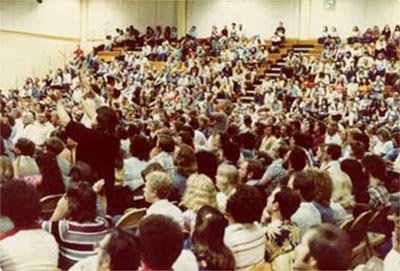Third Wave Revival
3 – John Wimber

John Wimber
John Wimber had been, in the words of Christianity Today, a “beer-guzzling, drug- abusing pop musician, who was converted at the age of 29 while chain-smoking his way through a Quaker-led Bible study.”
He had been a musician with the ‘The Righteous Brothers’ and his marriage was in serious trouble. In an effort to rebuild their disintegrating marriage, John and Carol were remarried in the local Catholic Church, as their former Baptist marriage wasn’t recognised.
They thought there was something positive in Christianity but didn’t find it amongst their Catholic friends, so thought they’d try the only other local church, the Quakers, in 1963. For English readers American Quakers are not the same as their English counterparts. They are more like British independent evangelical churches, doctrinally evangelical, very evangelistic and non-charismatic.
John found their Bible studies helpful as he was so full of questions about the Christian faith – anything from baptism or the Trinity to the death and resurrection of Jesus. Though he grew to love the Quakers dearly, he struggled with their culture and style of service.
One member, called ‘Gunner,’ a local welder in Yorba Linda, became a close friend and helped John and Carol explore Bible truths. He wisely waited until they were ready and the time was right, before praying with them and introducing them to Jesus.
Carol Wimber wrote: “It was right there, kneeling on the floor and sobbing . . . that John determined how he would spend the rest of his life – as a fool for Christ.”
God began speaking to John about his future, which at this stage was as a highly successful and well-respected musician. After reading the parable of the ‘Pearl of Great Price’ and seeking counsel from those around him, John gave up his musical career and began working in a factory, on a low wage.
John often taught about belonging to Jesus, saying, ‘I’m spare change in his pocket, he can spend me any way he wants.’ This was a principle that he practised first and foremost, before ever he taught it.
In his first years as a Christian, he led hundreds of people to Christ. By 1970 he was leading 11 Bible studies that included more than 500 people! He co-pastored a Quaker church for five years as a co-pastor in this rapidly growing Friends church.

Fuller School of World Mission
By 1974 John had enrolled in Peter Wagner’s Doctor of Ministry course in Church Growth at Fuller Theological Seminary. This opened him up to the wider church, whose people he always loved meeting. One of his popular maxims was ‘my brother is never my enemy,’ for he had come to love all parts of the wider church, even those with whom he didn’t necessarily agree. John was always an advocate of church unity and spent seasons of his life hanging out with different denominations and movements. He would insist that where the name of Jesus was honoured, be it among snake-handling churches or those worshipping with their candles and their incense, all who loved Jesus were his brothers and sisters.
In 1975 he was invited by Peter Wagner, to go to work with the Fuller Evangelistic Association. Wagner was teaching in the School of World Mission at the seminary and giving part-time leadership to the emerging Church Growth Department at the Evangelistic Association. John then took over the leadership of the Department of Church Growth at the Fuller Evangelistic Association and resigned from his role at the Friends (Quaker) Church in Yorba Linda.
For the next four years John worked with 27 denominations, nine parachurch organizations and hundreds of local churches. He traveled America speaking to thousands of pastors and serving as a church growth consultant, experiencing many different movements and denominations.
His time with the Fuller Evangelistic Association was a tremendous educational experience. The extensive exposure to church life he experienced during his term opened his eyes to the fact that God was bigger than he had ever realized.
But he no longer was personally involved in reaching the lost, and, as an evangelistically gifted Christian, that bothered him. God began to stir up in him a desire to return to the pastorate. John would often say how spiritually dull he felt during this time. But God continued to speak to him on several occasions, in preparation for the next stage of his ministry. One famous story told how God spoke to John clearly by saying: ‘I’ve seen your ministry, now I’m going to show you mine.’ Later in 1976 John received a word from a woman who approached him in tears saying: “God wants to know, ‘are you going to use your authority or not?’”
At this time, Carol was attended a small group named ‘Afterglow’ with her friends from the Quaker church. As they focussed their attention on the Holy Spirit, and enjoying His presence, God began to move and stories spread through the town of supernatural things happening in the group. The Quaker church sent one of their leaders to investigate and suggested shutting down the group. However, he visited again and concluded ‘I can’t shut the group down. It’s the Lord.’
John got involved and things came to a head when John spent time with the church elders sharing that he felt this was a ‘genuine outpouring of the Holy Spirit . . . if this is God – and I believe it is – we are going to let him do whatever he wants to do with us.’
The Quaker church did not really approve of what was happening in the group but graciously encouraged John and Carol to resign their membership, and together with about sixty other people, connected with Don McClure and became the Yorba Linda Calvary Chapel in May 1977.
As John and Carol began praying for the sick they began to see things happening – people getting well – but they didn’t fully understand it. Until one day John was poring over the Bible, trying to find answers, when he suddenly relaised: ‘We teach the word, then God does the work. Like tell and show, or show and tell! I think I get it!’ After this point healing became a larger and more prominent part of their ministry.
At this time John and Carol Wimber believed they were being led to join the Calvary Chapel movement, in part because Chuck Smith’s heart was to seek a balance between preaching the Word and seeking the Holy Spirit. In 1977 he started a Bible study at Yorba Linda and associated with a group of churches within the Calvary Chapel movement known as Vineyard churches.

Keith Green and Kenn Gulliksen
The Vineyard churches were originally started by Kenn Gulliksen, in West LA in 1974, also sent out by Calvary Chapel. From Gulliksen’s church, the first Vineyards were planted in 1975. Kenn gave the name “Vineyard” (from Isaiah 27:2-3; John 15:5) to this association of churches and led them for about five years. During this time he led Kieth Green to the Lord and in 1979 Bob Dylan adopted the Christian faith.
As John and his congregation, mostly made up of former Quakers, sought God in intimate worship, they experienced empowerment by the Holy Spirit, significant renewal in the gifts, and substantial conversion growth. The church hungered for more of the Holy Spirit, though they never could have imagined what this would mean.
On Mother’s Day 1980, John invited Lonnie Frisbee to share his testimony in the evening service. Lonnie was a seasoned convert from the Jesus Movement and an evangelist with Calvary Chapel. At the end of his talk, he invited Holy Spirit to come to the predominantly evangelical group.
The Spirit of God came with intense power. People who didn’t even believe in speaking in tongues began to speak in tongues, some loudly. People collapsed to the ground under this awesome power. One of them fell on top of a microphone, crying and speaking in tongues loudly, which added to the spiritual shockwave that invaded the auditorium. The whole church was filled with the strangest manifestations they had ever seen.
After this event, John stayed up all night searching the Scriptures and various histories of revivals for assurance that it was from the Lord. Though he still had some questions, he became convinced that this incredible visitation was from God.
The church’s large and small gatherings were gradually characterized by things that John had known about only from history books. Quaking, shaking, falling under the power of God, and the public exercise of spiritual gifts such as words of knowledge and prophecy became commonplace.

Yorba Linda Vineyard 1980
The outpouring of the Holy Spirit that day, and in the weeks that followed, brought tremendous church growth. The church grew from 400 in May, 1980 to over 1700 in three months, baptizing 700 people in the Wimber’s swimming pool.
But these strange phenomena did not fit well with Pastor Chuck Smith, founding leader of Calvary Chapel. Other leaders of Calvary Chapel began feeling uncomfortable with Wimber’s emphasis on the work of the Holy Spirit and they graciously agreed to release him to align with the other Vineyards and the “Association of Vineyard Churches” was born.
The official recognition of this transition took place in 1982. There were at least seven “Vineyards” in a loose-knit fellowship of churches and it was clear that John had emerged as the leader of this growing network of Vineyard churches.
Over a few years John’s conservative evangelical paradigm for understanding the ministry of the Church began to develop. George Eldon Ladd’s theological writings on the kingdom of God convinced him intellectually that all the biblical gifts of the Holy Spirit should be active in the Church. Encounters with Fuller missiologists Donald McGavaran and C. Peter Wagner, along with seasoned missionaries and international students, gave John credible evidence for combining evangelism with healing and prophecy.
As John became more convinced of God’s desire to be active in the world through all the biblical gifts of the Spirit, he began to teach and train his church to imitate Jesus’ full-orbed kingdom ministry. He began to “do the stuff” of the Bible, about which he had formerly only read about.
From this point the ministry exploded and a subsequent trip to the UK at the invitation of Anglicans and Baptists, saw John and Carol, with a team of young people from the Anaheim Vineyard, minister at St Andrews, Chorleywood and St Michael’s York. Both David Pytches and David Watson welcomed Wimber ‘s ministry and received his teams with great excitement. They were really the first to introduce John and Carol to the church in the United Kingdom.
St Andrew’s went on to play a pivotal part in the development of the Vineyard in the UK not least because of the Pytches’ close friendship with John and Carol, their leadership of the New Wine network and the Wimbers’ encouragement of New Wine and its summer festivals.
‘Signs, Wonders, & Church Growth’ (MC510) at Fuller
When the faculty of the School of World Mission of Fuller met to consider the role of the Holy Spirit in church growth they came up with the recommendation that an experimental course on the subject of signs, wonders and church growth be provided.
The course was approved in Fall 1981 and John Wimber was asked to lead the course alongside C. Peter Wagner and it was given the name “Signs, Wonders, & Church Growth.” In Summer 1983, the name was changed to “Healing Ministry and Church Growth.” The name changed again in Winter 1984 to “The Miraculous in Church Growth.”
MC510 drew attention from students, faculty and outside sources. The growing reputation was largely due to the particular teachings on miraculous healing and in-class practice of praying for the sick.
In the initial course Wimber taught on the works of Jesus, then trained seminarians to pray for the sick, hear God’s voice and move in the Holy Spirit. The material in this course eventually led to invitations for John and his team to train churches around the world in how to pray for and heal the sick.
The development of the Third Wave Movement across the world
From around 1984, John Wimber began exporting his new biblical discoveries, first in the US, then across the world in large, well-attended venues in principal cities of English-speaking nations.
Gradually he began to encourage the planting of churches internationally. Worldwide, Vineyard churches have been planted in many nations, including the U.S., Canada, Mexico, Central and South America, Russia, Turkey, Britain and throughout the European continent, Africa, Southeast Asia, and Australia. By 2007 there were more than 2400 Vineyard churches worldwide.
It would not be an overstatement to say that the Vineyard Movement of churches has not only been one of the fastest growing church streams in the latter part of the 20th century, but they have also had more influence than on any other movement in Pentecostal and Charismatic churches worldwide.
Third Wave Influencers
C. Peter Wagner and John Wimber were not alone in propagating third wave teachings and practices. There were others who recognised that another distinct “movement of the Holy Spirit,” was occurring among evangelicals who, for one reason or another, had chosen not to identify with either the Pentecostals or Charismatics.
Wagner wrote ‘Discover your spiritual gifts,’ ‘Your spiritual gifts can make your church grow’, ‘Growing in the Prophetic,’ ‘How to have a healing ministry without making you church sick’, ‘The Third Wave of the Holy Spirit,’ and a host of books on different forms of prayer, demonology, apostles and apostolic churches, et al.
John Wimber wrote ‘Power Healing’, ‘Power Evangelism’ and ‘Power Encounters.’
Charles Kraft also taught on the MC510 course from 1982 until 1985 and has also written influential books on the third wave, most prominently ‘Christianity with Power’, which explains his own journey to the third wave paradigm. In his book, he challenges the enlightenment influenced Western worldview and embraces the Holy Spirit’s power for ministry in signs and wonders.
Another key influencer of the third wave was Jack Deere, who created his own waves when he left Dallas Theological Seminary and a cessationist paradigm. He went on to write about his own transformation, especially in his first book ‘Surprised by the Power of the Spirit: Discovering How God Speaks and Heals Today’ (1993).
Surprisingly, another influential introduction to third wave emphases has been delivered by Nicky Gumbel, author and teacher of the Alpha course. The influence of John Wimber on Nicky Gumbel and the church that he serves at Holy Trinity Brompton, is seen predominantly in the teaching of the Holy Spirit, including a weekend addressing such topics as who the Holy Spirit is, what the Holy Spirit does, and how to be filled with the Spirit. The Holy Spirit weekend includes a moment in which participants are invited to ask to be filled with the Holy Spirit. In addition, a session of the course addresses the dynamic of resisting evil, introducing spiritual warfare, and deliverance. Another session addresses how God heals today, including the use of words of knowledge and persistent particular prayer, modeled after a pattern introduced to Nicky Gumbel at a meeting led by John Wimber at the Holy Trinity Brompton church in London, England.
Other men who have played an active role in propagation the Third Wave Movement, including Randy Clark, John Arnott, Rodney Howard-Brown, Bill Johnson and many others – but theirs is another story!
Resources:
John Wimber:Understanding John’s ministry and his legacy to us



